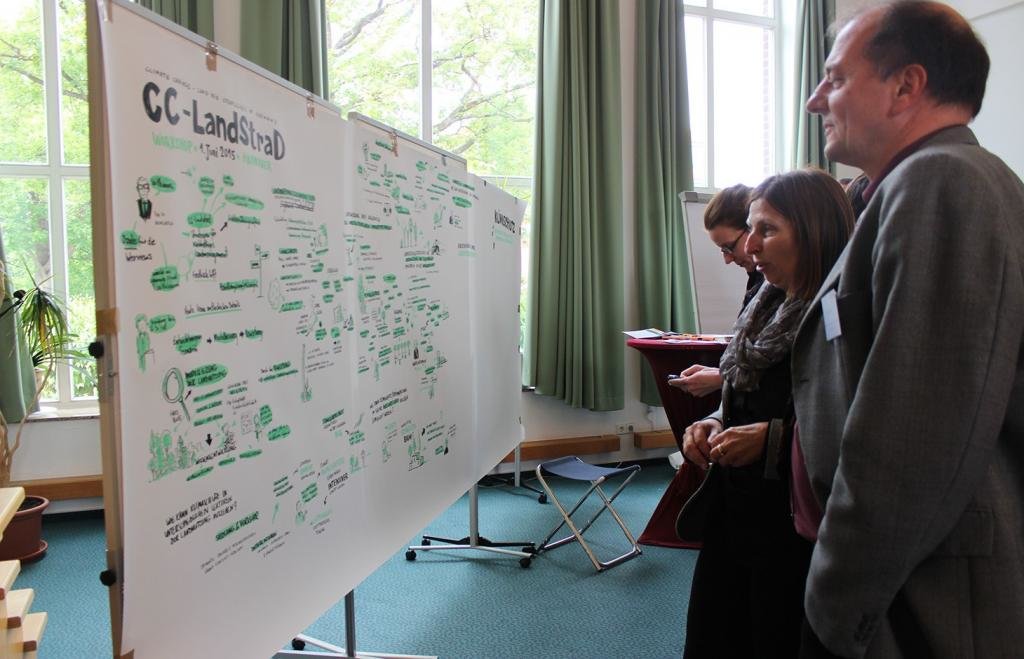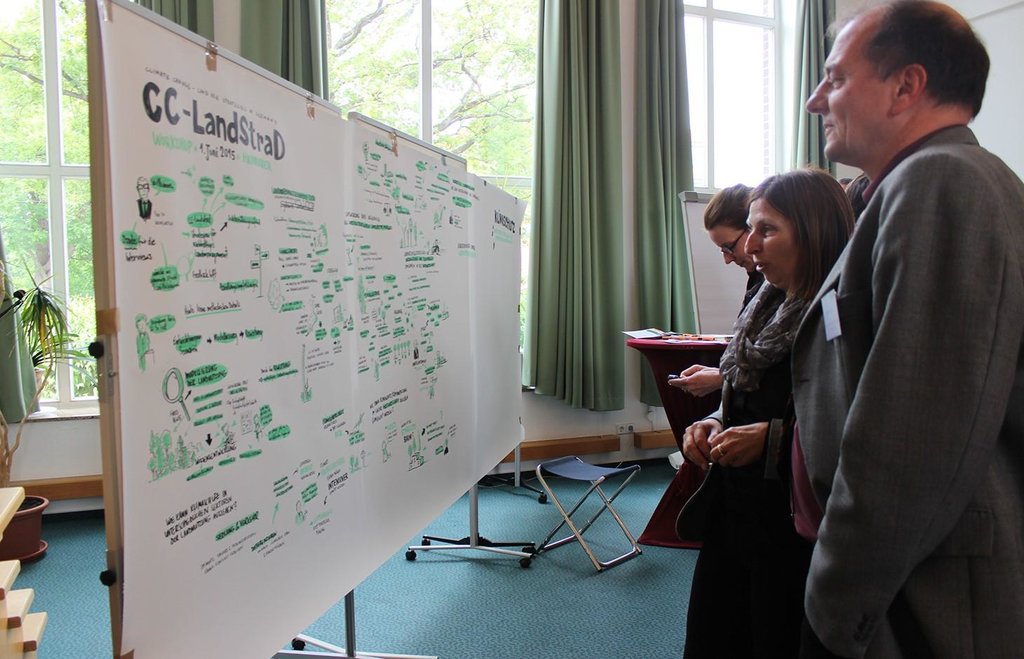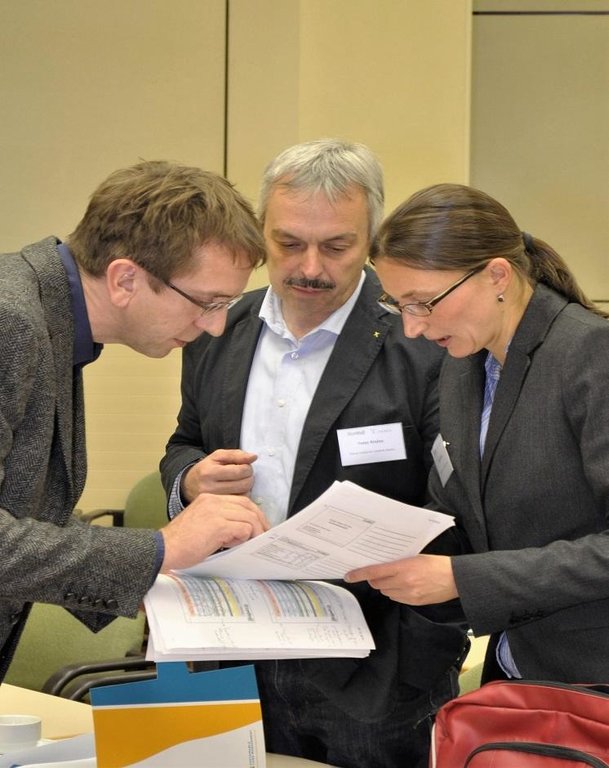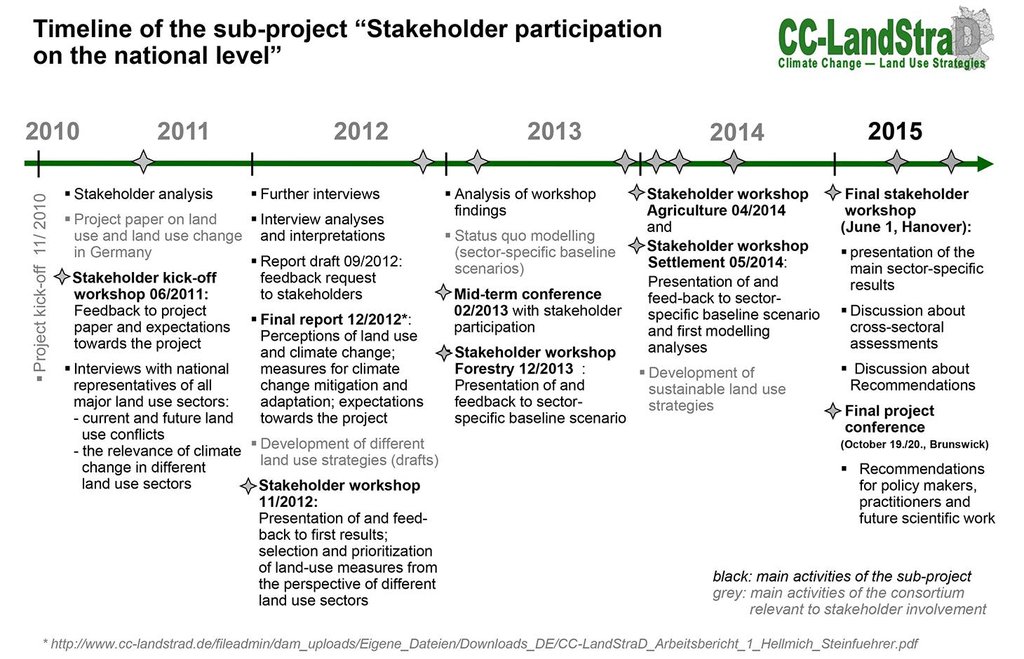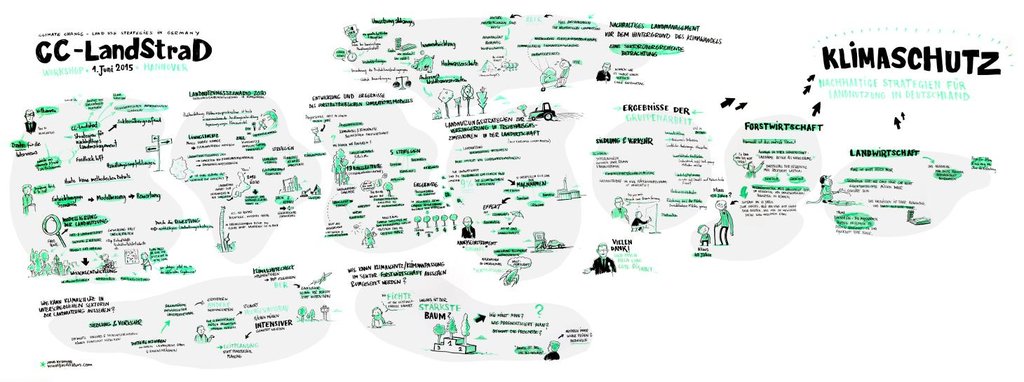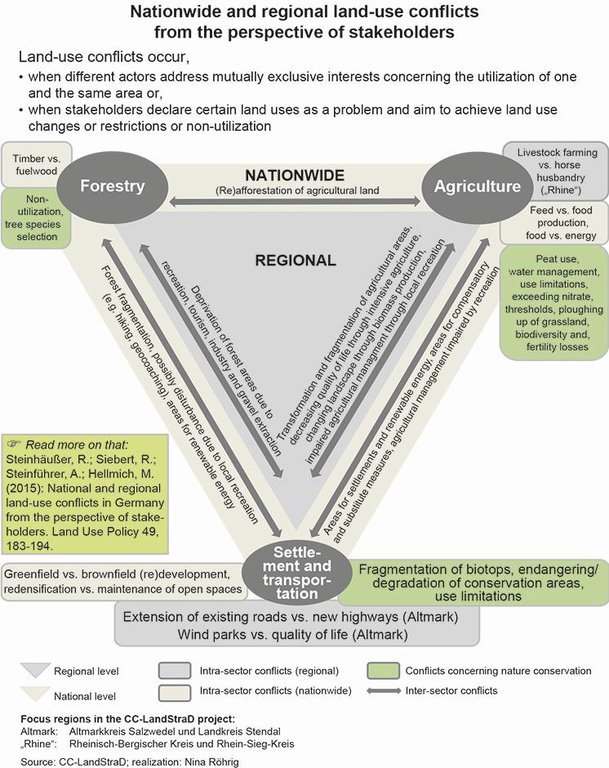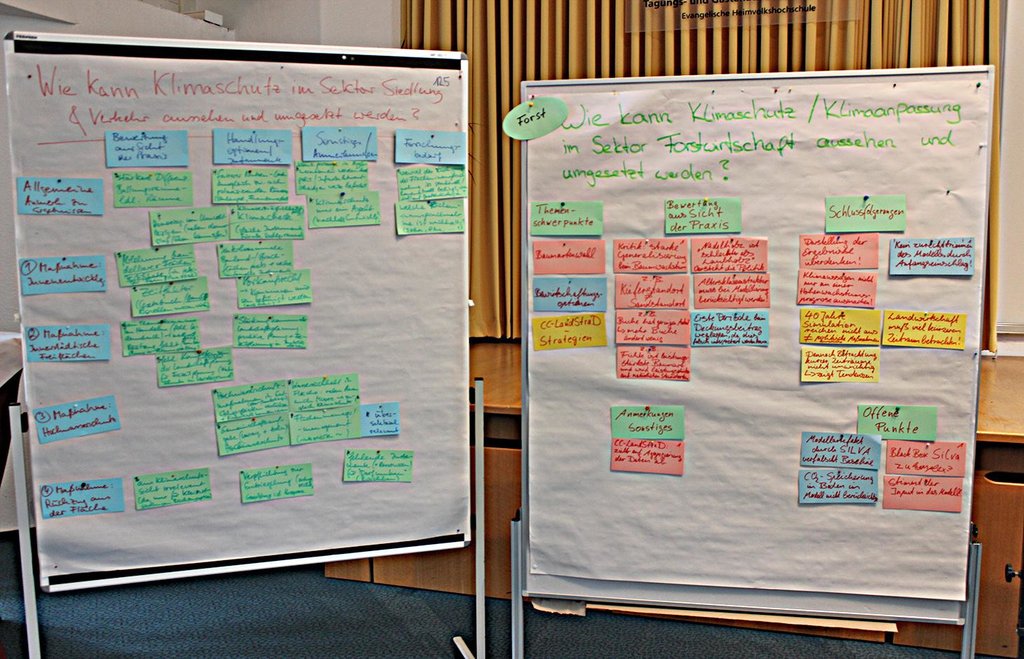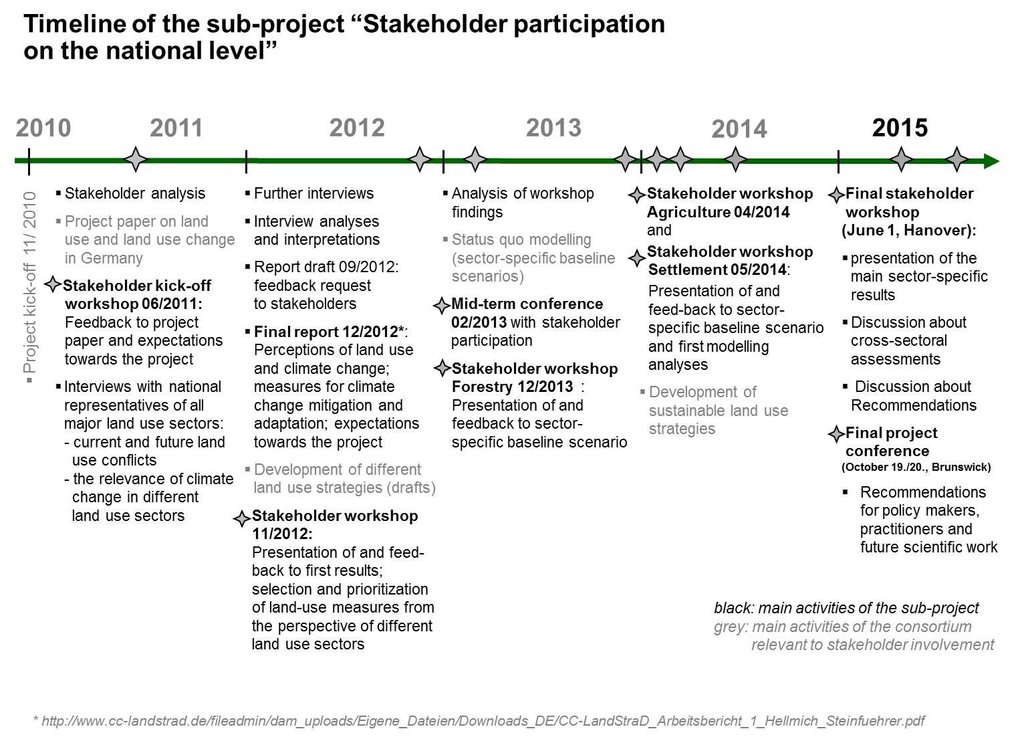Open dialogue platform on sustainable land management [Germany]
- Creation:
- Update:
- Compiler: Johanna Fick
- Editor: –
- Reviewers: Fabian Ottiger, Deborah Niggli
approaches_2605 - Germany
View sections
Expand all Collapse all1. General information
1.2 Contact details of resource persons and institutions involved in the assessment and documentation of the Approach
Name of project which facilitated the documentation/ evaluation of the Approach (if relevant)
Book project: Making sense of research for sustainable land management (GLUES)Name of the institution(s) which facilitated the documentation/ evaluation of the Approach (if relevant)
CC-LandStraD - GermanyName of the institution(s) which facilitated the documentation/ evaluation of the Approach (if relevant)
Thünen Institute (Thünen Institute) - Germany1.3 Conditions regarding the use of data documented through WOCAT
When were the data compiled (in the field)?
04/08/2015
The compiler and key resource person(s) accept the conditions regarding the use of data documented through WOCAT:
Yes
1.4 Reference(s) to Questionnaire(s) on SLM Technologies
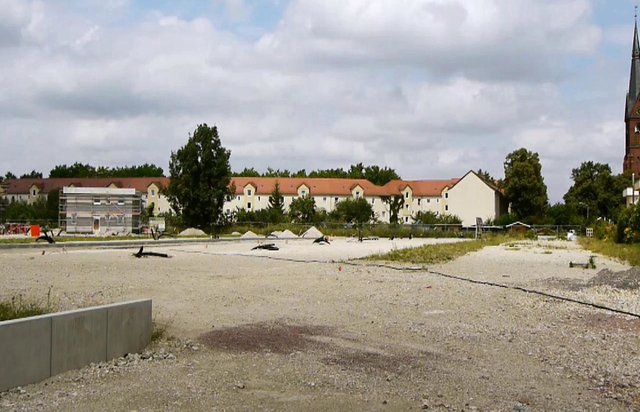
High-quality inner urban development [Germany]
A scenario simulation of land use change where high-quality inner urban development is promoted, including the rehabilitation of brownfields, reuse of vacant lots, use of gaps between buildings and the improvement of existing structures.
- Compiler: Johanna Fick
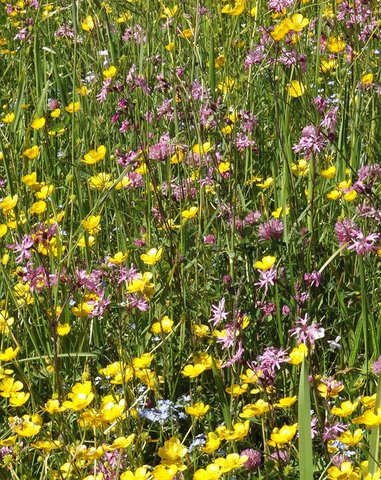
Grassland preservation [Germany]
Grassland preservation by the avoidance of ploughing up of grassland and its transformation into cropland
- Compiler: Johanna Fick
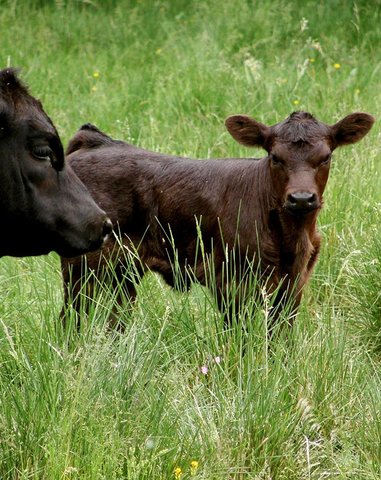
Adapted management of organic soils [Germany]
Re-wetting of organic soils and following adapted management suitable for wet conditions like extensive grazing land or paludiculture.
- Compiler: Johanna Fick
2. Description of the SLM Approach
2.1 Short description of the Approach
Establishing a dialogue platform on sustainable land management which is open to all stakeholders
2.2 Detailed description of the Approach
Detailed description of the Approach:
Aims / objectives: The cross-sectoral stakeholder discussion platform on SLM aims to involve all relevant stakeholders in a specific SLM topic, or within a particular region in a dialogue process leading to better understanding and to a sustainable solution where there are multifunctional claims on land. The platform operates in Germany.
Examples of possible topics are to work out, together, the main land use conflicts in a region (e.g. reduced land for agriculture because of increased settlement pressures) and then to jointly develop sustainable solutions for the land use conflicts addressed. The platform was established by a non-governmental group within a transdisciplinary research project (CC-LandStraD) financed by the Federal Ministry of Education and Research (BMBF) in Germany. The transdisciplinary research approach is carried out in cooperation with regional authorities.
The platform was established by a non-governmental group of researchers of a transdisciplinary research project financed by the Federal ministery of education and research in cooperation with regional authorities (transdisciplinary approach).
Methods: The platform provides a forum to discuss specific topics cross-sectorally (for example, agriculture, forestry, settlement and transportation, and nature conservation) and for multi-stakeholders (for example land users, advisors, specialists, planners, and decision makers). To establish this platform, a neutral setting and external moderation is helpful. Methods which can be used at the platform include separate sectoral and cross-sectoral workshops, excursions, information events and newsletters. Furthermore, there are simulations of different scenarios on current land use and on land use development and distribution, and at the same time there is cross-sectorial and transdisciplinary learning. This platform is not a single event, but an on-going process. Access barriers, for example an entrance fee, should not exist.
Stages of implementation: To initiate a platform, the most relevant aspects of a region/community and all related stakeholders have to be established through a stakeholder analysis. Interviews and surveys are employed to indicate who the relevant stakeholders are. During interviews the potential stakeholders are asked who they work with regarding land use. Further stages then focus on the most relevant aspects. These may be current land use conflicts like losses of agricultural land because of settlement and transportation infrastructure. Alternatively they can be conflicts regarding production of goods either for food, feed or energy purposes, or disputes concerning intensive or extensive agriculture, with the consequent implications on nature and environment conservation. Depending on which conflict is addressed, the relevant stakeholder and the process which is needed (e.g. sectoral talks, cross-sectoral talks, focus groups) can be identified. To identify the most relevant land use conflicts stakeholder are asked to rank the most relevant land use conflicts that affect them.
Role of stakeholders: Each stakeholder is welcomed and has the opportunity to state his/her opinion in an open-result discussion. The cross-sectoral learning process is an important aspect of this approach. In the case presented case there is interaction between stakeholders from agriculture, forestry and settlement/transport as well as nature conservation, regional and environmental planning and governmental institutions. The stakeholders were asked for the main land use conflicts in their work, relevant measures to resolve the situation, and their design, then discussed the scenario assumption, and selected results and possible implications.
2.3 Photos of the Approach
2.5 Country/ region/ locations where the Approach has been applied
Country:
Germany
Region/ State/ Province:
Germany, Saxony-Anhalt
Further specification of location:
Altmarkkreis Salzwedel and district Stendal (total area of region: 4744 km²)
2.6 Dates of initiation and termination of the Approach
Indicate year of initiation:
2010
Year of termination (if Approach is no longer applied):
2015
2.7 Type of Approach
- project/ programme based
2.8 Main aims/ objectives of the Approach
The Approach focused mainly on SLM with other activities (different interests on SLM in dialogue, cross-sectoral and with all related interest groups)
A cross-sectoral stakeholder discussion platform on SLM aims at involving all relevant stakeholders around a specific SLM topic, or within a particular region in a dialogue process leading to better understanding and improved, sustainable, solutions. In a “business as usual” situation, generally no cross sectoral talks or interaction take place. With such a platform however, more knowledge and direct talks between stakeholders from different sectors provide the opportunity for solutions.
The SLM Approach addressed the following problems: There are different and competing demands on land which can conflict with the conventional uses for agriculture and forestry. These include biomass for energy, new settlements and transportation infrastructure. Space is also needed for tourism and leisure facilities; and also for measures of environmental protection. All of these can have an impact on the area available for, and the management of, farmland and forests. And there are competing economic interests in land management. As land is a limited resource, problems between different stakeholders are inevitable and becoming more frequent.
2.9 Conditions enabling or hindering implementation of the Technology/ Technologies applied under the Approach
social/ cultural/ religious norms and values
- hindering
All stakeholder have different backgrounds and different levels of knowledge and interests. Sometimes the relevant stakeholders don't know each other.
Treatment through the SLM Approach: A neutral setting, so that no stakeholder has a(n) (dis)advantage and an external
moderation which is accepted by all involved stakeholders, and professional input by experts (e.g. from research institutions) so that a joint learning process starts. Here it is essential to provide a good atmosphere and a common understanding of the key questions.
availability/ access to financial resources and services
- hindering
Different stakeholders have different resources to contribute to this platform (e.g., time, finance, knowledge, equipment like beamer, microfons etc.).
Treatment through the SLM Approach: Trying to keep the barriers as low as possible and equal for each and every stakeholder (e.g. no entrance fee, public invitations in advance, central meeting location, meeting at a suitable time for the stakeholders).
legal framework (land tenure, land and water use rights)
- enabling
The existing land ownership, land use rights / water rights moderately helped the approach implementation: . The land ownership, land use rights/water rights are quite clear in Germany. So it is easy to identify the relevant stakeholders on SLM. But these are only a few target groups. There are much more which are relevant to get a good platform on SLM e.g. nature conservation groups, tourism associations.
workload, availability of manpower
- hindering
To implement and run a dialogue platform it takes time and professional skills and resources (e.g. high motivation and high frustration tolerance, moderation and motivation methods, knowledge about group dynamics).
Treatment through the SLM Approach: Be aware of this before the dialogue platform is set-up (such a process is not a one-off short-term, activity: it’s better thought of as medium-long term process).
other
- hindering
1. Stakeholders have different levels of knowledge and professionality
2. Previous conflicts (some known; some hidden) and other areas of controversy sometimes come to light during discussions.
Treatment through the SLM Approach: 1. It is necessary to make information accessible by moderation and to create common understanding (e.g. sometimes the same term exists in agriculture and forestry but has a different meaning).
2. Be sensitive to nonverbal communication or conflict topics and be prepared to deal with such issues even if not communicated verbally.
3. Participation and roles of stakeholders involved
3.1 Stakeholders involved in the Approach and their roles
- local land users/ local communities
Farmers, forest owners, counties, municipalities, associations on agriculture, forestry or nature conservation
Participating groups with less financial resources received travel grants
- SLM specialists/ agricultural advisers
- national government (planners, decision-makers)
Regional planners, planners on settlement and transport
On federal and county level
Remark: should include: agricultural, forestal, settlement and transport sector as well nature conservation. It is essentiell to deal with all of these people, that is the important part of this approach
If several stakeholders were involved, indicate lead agency:
We initiated this approach by a non-govenmental group of reseachers in cooperation with regional authorities. But this approach is not related to one body. Either national non-government or government or private sector or local government or local community/a group of land user can start the approach.
3.2 Involvement of local land users/ local communities in the different phases of the Approach
| Involvement of local land users/ local communities | Specify who was involved and describe activities | |
|---|---|---|
| initiation/ motivation | interactive | scientists working with transdisciplinary processes |
| planning | interactive | scientists on transdisciplinary processes and disciplinary scientists on SLM |
| implementation | passive | all involved stakeholders mentioned above = passive; scientists = interactive |
| monitoring/ evaluation | passive | all involved stakeholders mentioned above, scientists |
| Research | interactive | all involved stakeholders mentioned above and all scientists |
3.3 Flow chart (if available)
Description:
Time sheet stakeholder participation on national level.
The ‘sub-project' started in the first year with an overview workshop on current and future land use and climate change, followed by face-to-face interviews. The second year focused on the process to identify the most relevant measures for climate mitigation of each sector (agriculture, forestry, settlement and transportation, and nature conservation). The last three years were used to discuss preliminary results and to evaluate the results from the stakeholder perspectives.
Author:
Meike Hellmich, Annett Steinführer (Thünen-Institut Braunschweig)
3.4 Decision-making on the selection of SLM Technology/ Technologies
Were decisions on the selection of the Technology(ies) made:
- multi-stakeholder dialogue process
Explain:
Land users supported by SLM specialists e.g. an extensive management of grassland
SLM specialists with consultation of land users: practical test phase of new technology or innovative practise
by politicians / leaders (e.g. decisions regarding societal aims like environment protection)
Decisions on the method of implementing the SLM Technology were made by no decisions. No decisions have been made yet.
4. Technical support, capacity building, and knowledge management
4.1 Capacity building/ training
Was training provided to land users/ other stakeholders?
Yes
Specify who was trained:
- land users
- field staff/ advisers
- involved people
Subjects covered:
The activities focused on each level/stage (measures, scenarios, results and implication) to provide knowledge to and with all participants in order to focus on the meeting's objectives and to raise awareness (why are we doing this? why is it important to be here? why should we talk about this topic?).
4.2 Advisory service
Do land users have access to an advisory service?
Yes
Describe/ comments:
Advisory service is quite adequate to ensure the continuation of land conservation activities; The approach raised awareness and brought people together who normally don’t discuss topics with each other.
4.3 Institution strengthening (organizational development)
Have institutions been established or strengthened through the Approach?
- yes, a little
Specify the level(s) at which institutions have been strengthened or established:
- local
Describe institution, roles and responsibilities, members, etc.
This method can support local institutions via the input and mutual discussions of regional associations and groups. However, certain groups may mutually exclude each other.
4.4 Monitoring and evaluation
Is monitoring and evaluation part of the Approach?
Yes
Comments:
socio-cultural aspects were monitored by project staff through observations; indicators: Interviews by scientists at the project end regarding cross-sectoral and transdisciplinary approach
There were no changes in the Approach as a result of monitoring and evaluation
There were no changes in the Technology as a result of monitoring and evaluation
4.5 Research
Was research part of the Approach?
Yes
Specify topics:
- sociology
- economics / marketing
- ecology
Give further details and indicate who did the research:
Simulation of land use development in Germany was undertaken, including simulation of agricultural economics, forest economics and simulation of settlement and transport areas development, of GHG emissions of land use, and a population survey on perceptions of landscapes
Research was carried out on station
5. Financing and external material support
5.1 Annual budget for the SLM component of the Approach
If precise annual budget is not known, indicate range:
- < 2,000
Comments (e.g. main sources of funding/ major donors):
Approach costs were met by the following donors: government: 95.0%; local government (district, county, municipality, village etc): 5.0%
5.2 Financial/ material support provided to land users
Did land users receive financial/ material support for implementing the Technology/ Technologies?
No
5.3 Subsidies for specific inputs (including labour)
- none
Comments:
Time which was needed to take part in the dialogue platform other inputs not relevant
5.4 Credit
Was credit provided under the Approach for SLM activities?
No
6. Impact analysis and concluding statements
6.1 Impacts of the Approach
Did the Approach help land users to implement and maintain SLM Technologies?
- No
- Yes, little
- Yes, moderately
- Yes, greatly
The complex topic land use and climate change (with focus on climate change mitigation) was analysed and presented to the involved stakeholders. The interaction during cross-sectoral workshops gave a more detailed picture on SLM compared with workshops with a sectoral focus. The better knowledge base helps to improve SLM.
Did the Approach empower socially and economically disadvantaged groups?
- No
- Yes, little
- Yes, moderately
- Yes, greatly
Not in the focus
Did other land users / projects adopt the Approach?
- No
- Yes, little
- Yes, moderately
- Yes, greatly
The approach is also used in regional development processes sometimes.
Did the Approach lead to improved livelihoods / human well-being?
- No
- Yes, little
- Yes, moderately
- Yes, greatly
; the awareness of intensive land use in Germany and in our focus regions was raised, especially regarding the interaction between agricultural land use and (for example) water quality because of intensive agriculture including the application of fertilizers, pesticides or herbicides. Often these chemical inputs cannot absorbed by plants or soil so the unused resources concentrate in groundwater and thus needs to purified before drinking. Land use improvements can be achieved by agreeing the division between settlement, transport and land for agricultural production - and also for sustainable land use to reduce GHG emissions in agriculture and forestry.
Did the Approach help to alleviate poverty?
- No
- Yes, little
- Yes, moderately
- Yes, greatly
6.2 Main motivation of land users to implement SLM
- affiliation to movement/ project/ group/ networks
in this approach all land using sectors were involved for the first time
6.3 Sustainability of Approach activities
Can the land users sustain what has been implemented through the Approach (without external support)?
- yes
If yes, describe how:
This approach is suitable for different levels, for different topics or different stakeholders involved.
6.4 Strengths/ advantages of the Approach
| Strengths/ advantages/ opportunities in the land user’s view |
|---|
| New information, innovative methods and results, current political trends (How to sustain/ enhance this strength: Presentation of new information has to be in a language adequate for the target groups.) |
| Strengths/ advantages/ opportunities in the compiler’s or other key resource person’s view |
|---|
| Added value e.g. research can be needed to get new input (How to sustain/ enhance this strength: Clear announcement of added value for different target groups) |
| All relevant stakeholders are involved (How to sustain/ enhance this strength: make sure that all relevant stakeholders are identified during the initial stakeholder analysis.) |
| Cross-sectoral and sectoral meetings by turns, depending on specific aspects of the meeting (How to sustain/ enhance this strength: Problem and solution oriented talks and meetings) |
| Neutral setting and external moderation |
| New information and knowledge by researcher is shared (How to sustain/ enhance this strength: Cooperation with research institution) |
6.5 Weaknesses/ disadvantages of the Approach and ways of overcoming them
| Weaknesses/ disadvantages/ risks in the land user’s view | How can they be overcome? |
|---|---|
| There should be an added value for land user and the added value should be addressed clearly. | e.g. new information provided by researcher must be tailored to the different stakeholders. |
| Weaknesses/ disadvantages/ risks in the compiler’s or other key resource person’s view | How can they be overcome? |
|---|---|
| It takes time to produce the right working atmosphere and to reach a common language. | Avoid short-term initiatives. |
|
The moderation has to be accepted by all stakeholders. |
7. References and links
7.1 Methods/ sources of information
- field visits, field surveys
- interviews with land users
7.2 References to available publications
Title, author, year, ISBN:
Steinhäußer, R. et al. (2015) National and regional land-use conflicts in Germany from the perspective of stakeholders
Available from where? Costs?
Land UsePolicy 49, 183-194
Title, author, year, ISBN:
• Lange, A.; Siebert, R.; Barkmann, T. (2016) Incrementality and Regional Bridging: Instruments for Promoting Stakeholder Participation in Land Use Management in Northern Germany.
Available from where? Costs?
Society & Natural Resources , Jul2016, Vol. 29 Issue 7, p868-879, 12p.
Links and modules
Expand all Collapse allLinks

High-quality inner urban development [Germany]
A scenario simulation of land use change where high-quality inner urban development is promoted, including the rehabilitation of brownfields, reuse of vacant lots, use of gaps between buildings and the improvement of existing structures.
- Compiler: Johanna Fick

Grassland preservation [Germany]
Grassland preservation by the avoidance of ploughing up of grassland and its transformation into cropland
- Compiler: Johanna Fick

Adapted management of organic soils [Germany]
Re-wetting of organic soils and following adapted management suitable for wet conditions like extensive grazing land or paludiculture.
- Compiler: Johanna Fick
Modules
No modules



